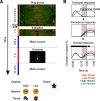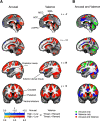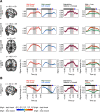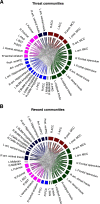Threat and Reward Imminence Processing in the Human Brain
- PMID: 36927571
- PMCID: PMC10124955
- DOI: 10.1523/JNEUROSCI.1778-22.2023
Threat and Reward Imminence Processing in the Human Brain
Abstract
In the human brain, aversive and appetitive processing have been studied with controlled stimuli in rather static settings. In addition, the extent to which aversive-related and appetitive-related processing engage distinct or overlapping circuits remains poorly understood. Here, we sought to investigate the dynamics of aversive and appetitive processing while male and female participants engaged in comparable trials involving threat avoidance or reward seeking. A central goal was to characterize the temporal evolution of responses during periods of threat or reward imminence. For example, in the aversive domain, we predicted that the bed nucleus of the stria terminalis (BST), but not the amygdala, would exhibit anticipatory responses given the role of the former in anxious apprehension. We also predicted that the periaqueductal gray (PAG) would exhibit threat-proximity responses based on its involvement in proximal-threat processes, and that the ventral striatum would exhibit threat-imminence responses given its role in threat escape in rodents. Overall, we uncovered imminence-related temporally increasing ("ramping") responses in multiple brain regions, including the BST, PAG, and ventral striatum, subcortically, and dorsal anterior insula and anterior midcingulate, cortically. Whereas the ventral striatum generated anticipatory responses in the proximity of reward as expected, it also exhibited threat-related imminence responses. In fact, across multiple brain regions, we observed a main effect of arousal. In other words, we uncovered extensive temporally evolving, imminence-related processing in both the aversive and appetitive domain, suggesting that distributed brain circuits are dynamically engaged during the processing of biologically relevant information regardless of valence, findings further supported by network analysis.SIGNIFICANCE STATEMENT In the human brain, aversive and appetitive processing have been studied with controlled stimuli in rather static settings. Here, we sought to investigate the dynamics of aversive/appetitive processing while participants engaged in trials involving threat avoidance or reward seeking. A central goal was to characterize the temporal evolution of responses during periods of threat or reward imminence. We uncovered imminence-related temporally increasing ("ramping") responses in multiple brain regions, including the bed nucleus of the stria terminalis, periaqueductal gray, and ventral striatum, subcortically, and dorsal anterior insula and anterior midcingulate, cortically. Overall, we uncovered extensive temporally evolving, imminence-related processing in both the aversive and appetitive domain, suggesting that distributed brain circuits are dynamically engaged during the processing of biologically relevant information regardless of valence.
Keywords: anxiety; reward; threat.
Copyright © 2023 the authors.
Figures










Update of
-
Threat and reward imminence processing in the human brain.bioRxiv [Preprint]. 2023 Jan 20:2023.01.20.524987. doi: 10.1101/2023.01.20.524987. bioRxiv. 2023. Update in: J Neurosci. 2023 Apr 19;43(16):2973-2987. doi: 10.1523/JNEUROSCI.1778-22.2023. PMID: 36711746 Free PMC article. Updated. Preprint.
References
Publication types
MeSH terms
Grants and funding
LinkOut - more resources
Full Text Sources
